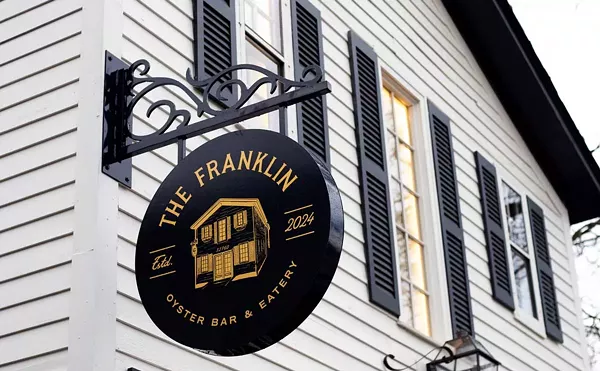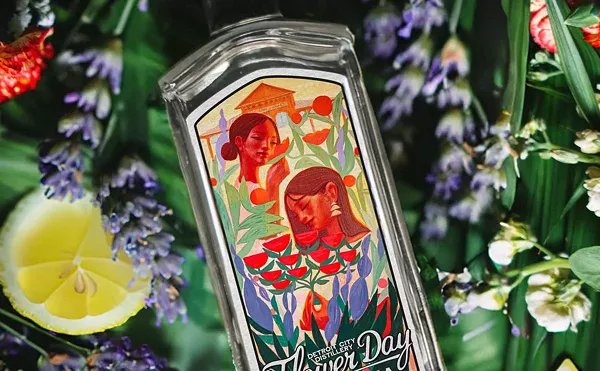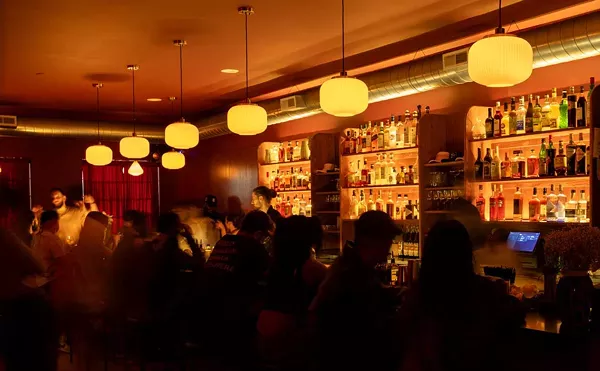
Audio By Carbonatix
[
{
"name": "GPT - Leaderboard - Inline - Content",
"component": "35519556",
"insertPoint": "5th",
"startingPoint": "3",
"requiredCountToDisplay": "3",
"maxInsertions": 100,
"adList": [
{
"adPreset": "LeaderboardInline"
}
]
}
]
My fascination with cookbooks did not begin in our diet-free kitchen where, in times of trouble, my mother would whip up the most incredible cakes, or in the afterglow of a luxurious dinner at a five-star restaurant.
No.
My interest in food was prompted by Peter Greenaway’s cannibals of high art in The Cook, the Thief, His Wife & Her Lover, and by Lenny Henry’s "Chef!," one of the funniest British shows on TV.
To put it more precisely: I never longed to dazzle anyone with my profiteroles au chocolat, my escalopes a la Florentine or my canard a l’orange; I simply love to use the "small c" arts – couture, coiffure, cuisine – to talk about fictional characters in terms of their style, taste, palate.
It’s an amusing exercise; you should try it sometime. Take Casablanca, for instance. Whenever Laszlo orders a drink, it’s something different: Cointreau, cocktail, cognac, whiskey.
"Why such confusing and confused drinking habits?" Umberto Eco asks in Travels in Hyperreality. Because director Michael Curtiz was simply "quoting" familiar scenes from other movies. His characters seem so delightfully enigmatic precisely because they have no habits of their own.
The result? An eminently quotable cult movie – and all of this deduced from a list of drinks.
But there’s more. In Absinthe, History in a Bottle (Chronicle Books, $19.95, 172 pp.), Barnaby Conrad III talks of "The Green Fairy" as "the skeleton key to the fin de siècle’s secrets."
After all, didn’t absinthe inspire the most beautiful poems of Alfred de Musset; didn’t it keep Verlaine company as he dreamt of Rimbaud; didn’t it tickle the fancy of Toulouse-Lautrec, Gauguin, Van Gogh, Picasso and Oscar Wilde? ("What difference is there between a glass of absinthe and a sunset?")
Come on, what more can you ask of a drink? Two hangovers and a delirium tremens?
Enough about the devil’s elixir! Back to cookbooks.
A few days ago, as I was rummaging through the shelves of a mystery bookstore, I found Madame Maigret’s Recipes, by Robert J. Courtine (Harcourt Brace Jovanovich, $5.95, 183 pp.), the notebook in which the great (fictional) commissar’s wife had copied her favorite recipes. And thank god for that: We have no Mrs. Holmes to talk about Sherlock’s addictions – tobacco and a delightful 7 percent solution; no Mrs. Poirot to discuss the Belgian detective’s fondness of tisane and chocolate; no Mrs. Jack the Ripper to share with us the secrets of fine cutlery.
Louise Maigret’s dishes, on the other hand – elegant, simple, so damn French! – offer us a peek into Maigret’s soul: "Holding his jacket over one arm, Maigret put his key in the lock. He called out his traditional ‘It’s me!’ and sniffed, trying to guess from the smell what there would be for lunch. ..."
And now this – Gourmet Cannabis Cookery: The High Art of Marijuana Cuisine, by Dan D. Lyon (Loompanics Unlimited, $10, 90 pp.) – the culinary bible of the true outlaw, the latest buzz on pot-enhanced foods.
So why cook with pot? "Cause eating it is healthier than smoking it, more economical (if you have a garden), and less dangerous since you don’t have to venture out in possession of "baggies, papers or pipes."
As Dan D. Lyon puts it, "If you like to go out and party, you can eat a couple of pot peanut butter cookies and stay buzzed all night and not have to worry about smelling like a bong ... Better be a free Drug War resister than a jailed Drug War victim."
But Dan D. Lyon’s (why not Vy O’Lette’s?) book does more than just throw together a few quick recipes for breakfast, snacks and dinner. It suggests that behind the freedom of cooking with marijuana lies the real issue of freedom in "our neototalitarian police state" whose main mission seems to be the systematic brainwashing of its citizens.
"Why do I point this out? Because many people do not know that they are free. They think that freedom is a gift bestowed upon them by a benevolent state, and that it is their nature and destiny to obey the wishes of others or face the consequences. Bullshit. ‘Benevolent state’ is an oxymoron," says Lyon.
So maybe subtlety is not Lyon’s forte, but – let us not forget – this is after all a cookbook, a manual of food preparation whose "narrative voice" digresses – at times – from its own digressions, in order to rave about violence, power, control, morality, Chinese sayings, the Declaration of Independence, and the attempt of the U.S. military to exterminate "the uncooperative Apaches and Vietnamese."
In the midst of this political salad, however, we do get sound advice – "don’t eat uncooked marijuana" – and a bunch of practical suggestions concerning the preparation of herbal butter and herbal olive oil necessary for cooking.
The first chapter contains not only "some basic growing tips," but also a fair warning: "In present day Amerika ingenuity and productivity are punishable by imprisonment, theft of your belongings (‘civil asset forfeiture’) and, in some cases, death. You can serve more prison time for growing marijuana than you can for raping and killing hitchhikers."
Invigorated by this caveat, you can then go about your (risky) business in the kitchen, more Robin Hood than Emeril, and prepare a whole feast (six courses, no less) for all your merry outlawed friends.
Start with a few drinks, such as Moo Juice (Coffee-Pot Liqueur, chocolate milk mix and cold milk), or Herbal Tincture (1 ounce cleaned, chopped dry herb and one fifth vodka).
Following Lyon’s advice, think of the whole process as a reconciliation between the worlds of Man (who made alcohol) and God (who made pot). Then serve herb-laced sausage balls, pizza, garlic bread, Rasta shrimp, a salad ("sorry, no low-fat rabbit food recipes here"), and a delicious spaghetti dish which your guests would gladly remember if they could.
End the meal with cookies and chocolate cake, or marijuana brownies that "can get you stoned to the bone." Then draw the curtain over the rest of the evening and enjoy your newly acquired – though illusory – freedom for as long as the buzz lasts.





